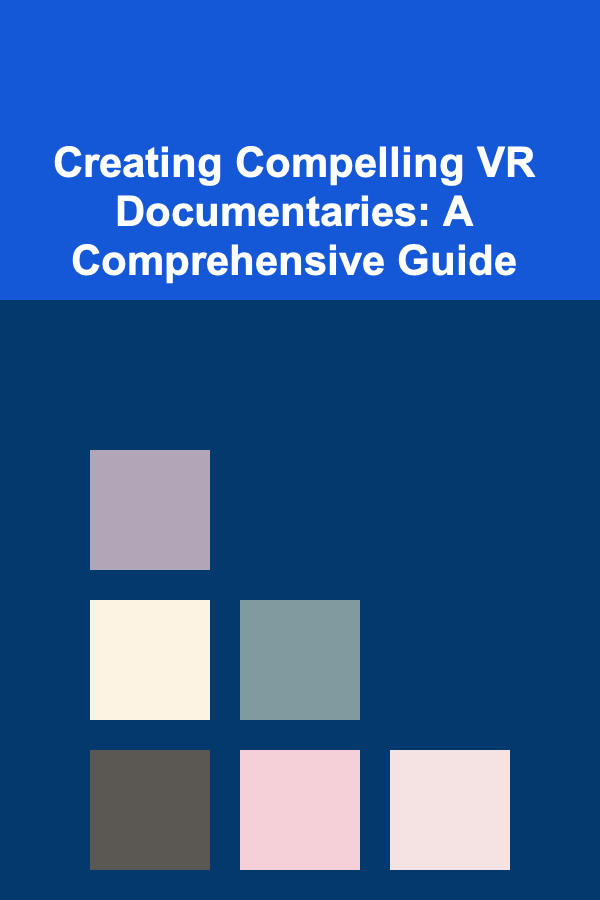
Creating Compelling VR Documentaries: A Comprehensive Guide
ebook include PDF & Audio bundle (Micro Guide)
$12.99$10.99
Limited Time Offer! Order within the next:

Introduction: The Immersive Power of VR Documentaries
Virtual Reality (VR) has revolutionized how we experience media, offering an unparalleled sense of presence and immersion. This transformative technology is particularly potent for documentary filmmaking, allowing viewers to step into the stories of others and witness events firsthand in a way that traditional documentaries simply cannot replicate. VR documentaries offer a unique opportunity to foster empathy, deepen understanding, and create truly impactful narratives.
However, crafting a successful VR documentary is a complex undertaking that requires a different skillset and approach than traditional filmmaking. It's not merely about filming in 360 degrees; it's about leveraging the unique affordances of VR to tell a compelling and meaningful story. This guide will provide a comprehensive overview of the key considerations, techniques, and best practices for creating impactful VR documentaries.
I. Conceptualization and Pre-Production: Laying the Foundation for Immersion
A. Choosing the Right Story: Subject Matter and Ethical Considerations
Not every story translates well into VR. The ideal VR documentary subject should benefit from the immersive nature of the medium. Consider stories that involve:
- Empathy and perspective-taking: Stories that allow viewers to understand a different culture, experience a challenging situation, or see the world through someone else's eyes.
- Presence and embodiment: Experiences where being "present" in the environment is crucial to understanding the story, such as exploring a refugee camp, witnessing a natural disaster, or attending a cultural ceremony.
- Spatial understanding: Stories that rely on the environment itself to convey meaning, such as exploring historical sites, architectural marvels, or endangered ecosystems.
Furthermore, ethical considerations are paramount. VR's immersive nature amplifies the impact of the content, making responsible storytelling crucial. Consider the following:
- Informed consent: Ensure all participants fully understand the implications of appearing in a VR documentary and provide informed consent. Explain how the footage will be used, who will have access to it, and the potential impact on their lives.
- Accuracy and representation: Strive for accuracy and avoid sensationalism or exploitation. Represent your subjects fairly and avoid perpetuating harmful stereotypes.
- Emotional impact: Be mindful of the emotional impact of the experience on viewers, especially when dealing with sensitive topics. Consider providing trigger warnings or resources for viewers who may be affected.
- Privacy and security: Protect the privacy and security of your subjects, especially in sensitive environments or when dealing with vulnerable populations. Blur faces, anonymize data, or take other measures to safeguard their identity.
B. Research and Scripting: Planning for a 360-Degree World
Thorough research is essential for any documentary, but it's even more critical in VR. You need to understand the environment, the people, and the context of your story intimately. This includes:
- Background research: Gather as much information as possible about the subject matter, the location, and the people involved. Read books, articles, watch other documentaries, and consult with experts.
- Location scouting: Visit the location and get a feel for the space. Identify potential shooting locations, assess lighting conditions, and consider logistical challenges.
- Interview pre-production: Develop interview questions that are tailored for VR. Consider how the subject's physical presence and body language will contribute to the narrative.
Scripting for VR is different from traditional filmmaking. You're not just telling a story; you're creating an experience. Consider the following:
- Spatial storytelling: Think about how the environment itself can contribute to the narrative. How can you use sound, light, and movement to guide the viewer's attention and create a sense of immersion?
- User agency and control: Balance narrative control with user agency. Allow viewers to explore the environment at their own pace, but guide them towards key moments and information.
- "Comfort zones" and navigation: Be mindful of viewer comfort. Avoid sudden movements or disorienting camera angles that can cause motion sickness. Provide clear visual cues to help viewers navigate the environment.
- Avoid traditional "cuts": Avoid rapid cuts, as they can be disorienting in VR. Instead, use spatial audio cues, gradual transitions, or interactive elements to guide the viewer's attention.
C. Storyboarding and Visualization: Mapping Out the Immersive Experience
Storyboarding is a crucial tool for visualizing the VR experience. However, traditional storyboards, which focus on a single frame, are insufficient for VR. Instead, use:
- 360-degree storyboards: Create storyboards that depict the entire 360-degree environment. You can use specialized software, hand-drawn sketches, or even photographs to create these visual representations.
- Spatial annotations: Annotate your storyboards to indicate important spatial elements, such as sound cues, interactive elements, and areas of interest.
- VR prototyping: Create simple VR prototypes using game engines or 360-degree editing software. This allows you to test your ideas and identify potential problems before you start filming.
Consider using pre-visualization tools to plan camera movements and subject placement within the 360-degree space. This will help you ensure that the composition is visually appealing and that the viewer's attention is directed to the appropriate areas.
II. Production: Capturing the Immersive Footage
A. Choosing the Right VR Camera: Hardware Considerations
Selecting the right VR camera is crucial for capturing high-quality footage. Several factors should be considered:
- Resolution: Higher resolution is essential for creating a sharp and immersive experience. Aim for a minimum resolution of 4K per eye, and ideally 8K or higher.
- Frame rate: A higher frame rate (30fps or higher) will result in smoother and more comfortable viewing experience, especially during scenes with movement.
- Dynamic range: A wide dynamic range will allow you to capture details in both bright and dark areas of the scene.
- Stabilization: Image stabilization is crucial for reducing motion sickness. Consider using cameras with built-in stabilization or external stabilizers.
- Audio capabilities: Ensure the camera has good audio recording capabilities or the ability to connect to external microphones. Spatial audio is critical for creating a truly immersive experience.
- Budget: VR cameras range in price from a few hundred dollars to tens of thousands of dollars. Choose a camera that fits your budget and meets your technical requirements.
Popular VR camera options include:
- Insta360 Pro 2
- GoPro Max
- Z CAM V1 Pro
- Facebook (Meta) Surround 360
B. On-Set Techniques: Capturing Compelling 360-Degree Footage
Shooting in VR requires a different set of techniques than traditional filmmaking. Here are some key considerations:
- Camera placement: Carefully consider camera placement. The camera becomes the viewer's eyes, so position it in a way that provides a compelling perspective and encourages exploration.
- Composition and framing: Pay attention to composition and framing. Use leading lines, symmetry, and other visual techniques to guide the viewer's attention. Avoid placing important elements at the top or bottom of the frame, as they may be cut off in some VR headsets.
- Lighting: Lighting is crucial for creating a sense of realism and immersion. Use natural light whenever possible, and supplement it with artificial light as needed. Avoid harsh shadows and overly bright highlights.
- Movement: Camera movement should be deliberate and purposeful. Avoid jerky or unnecessary movements that can cause motion sickness. Consider using dollies, gimbals, or drones to create smooth and controlled camera movements.
- Blocking and performance: Direct actors to perform in a way that is natural and engaging for the viewer. Encourage them to make eye contact with the camera and to move around the space in a believable way.
- Hiding the crew: One of the biggest challenges in VR is hiding the crew. Use creative camera angles, strategic placement of objects, or digital removal techniques to keep the crew out of the shot.
C. Audio Capture: The Importance of Spatial Sound
Audio is just as important as visuals in creating an immersive VR experience. Spatial audio, which simulates the way we hear sound in the real world, is crucial for creating a sense of presence and realism.
- Ambisonic recording: Use an ambisonic microphone to capture sound from all directions. This will allow you to create a 360-degree soundscape that matches the visuals.
- Binaural recording: Use binaural microphones to capture sound as it enters the ears. This creates a highly realistic and immersive audio experience when viewed with headphones.
- Sound design: Pay attention to sound design. Use sound effects, music, and narration to enhance the narrative and create a sense of atmosphere.
- Synchronization: Ensure that the audio and video are properly synchronized. Even a slight delay can break the illusion of immersion.
Consider using spatial audio mixing tools to create a realistic and immersive soundscape. These tools allow you to position sounds in 3D space and adjust their volume, panning, and other parameters.
III. Post-Production: Crafting the Final Immersive Experience
A. Stitching and Editing: Assembling the 360-Degree Puzzle
Stitching the footage from multiple cameras is a critical step in the VR post-production process. This involves aligning and blending the images to create a seamless 360-degree view. Several software options are available for stitching, including:
- Mistika VR
- Autopano Video Pro
- Kolor Autopano Giga
- Adobe After Effects (with specialized plugins)
During the stitching process, pay attention to:
- Parallax errors: Parallax errors occur when objects appear to shift position relative to the camera. Use stitching software to minimize these errors.
- Seam lines: Seam lines are visible lines where the images from different cameras are joined together. Use blending and masking techniques to hide these lines.
- Color correction: Ensure that the colors and brightness levels are consistent across all cameras. Use color correction tools to match the images.
Editing VR footage requires a different approach than traditional editing. Consider the following:
- Gradual transitions: Use gradual transitions, such as fades and dissolves, instead of abrupt cuts. This will help to avoid disorientation.
- Spatial audio cues: Use spatial audio cues to guide the viewer's attention and create smooth transitions between scenes.
- User agency: Allow viewers to explore the environment and interact with the story. Use interactive elements, such as hotspots and branching narratives, to give viewers a sense of control.
- Testing: Test your VR documentary on different headsets and platforms to ensure that it looks and performs as intended.
B. Visual Effects and Compositing: Enhancing the Immersive Reality
Visual effects (VFX) can be used to enhance the VR experience, remove unwanted elements, and create special effects. Common VFX techniques used in VR documentaries include:
- Object removal: Removing unwanted objects, such as crew members or equipment, from the scene.
- Digital stitching: Correcting stitching errors and creating seamless transitions.
- Color grading: Adjusting the colors and brightness levels to create a specific mood or atmosphere.
- Adding graphics and text: Adding informative graphics and text to enhance the narrative.
- Creating special effects: Adding special effects, such as explosions or simulations, to create a more dramatic or engaging experience.
Compositing involves combining multiple visual elements into a single image. This can be used to create complex scenes, add visual effects, and integrate graphics into the VR environment.
C. Audio Mixing and Mastering: Creating the Immersive Soundscape
Audio mixing and mastering are essential for creating a high-quality and immersive soundscape. This involves:
- Balancing audio levels: Adjusting the volume of different audio elements to create a balanced and clear soundscape.
- Adding effects: Adding effects, such as reverb and delay, to create a sense of space and depth.
- Spatialization: Positioning sounds in 3D space to create a realistic and immersive audio experience.
- Mastering: Optimizing the audio for playback on different devices and platforms.
Use spatial audio mixing tools to position sounds in 3D space and create a realistic soundscape. Pay attention to the direction, distance, and movement of sounds to create a sense of presence and immersion.
D. Optimizing for VR Headsets and Platforms: Ensuring a Smooth Experience
Optimizing your VR documentary for different headsets and platforms is crucial for ensuring a smooth and enjoyable viewing experience. Consider the following:
- Resolution and frame rate: Optimize the resolution and frame rate of your video for the target headset. Higher resolution and frame rate require more processing power, so you may need to reduce these settings for lower-end headsets.
- Video codec: Use a video codec that is supported by the target platform. H.264 and H.265 are common codecs for VR video.
- Bitrate: Adjust the bitrate of your video to balance image quality and file size. A higher bitrate will result in better image quality, but it will also increase the file size.
- Head tracking: Ensure that your VR documentary supports head tracking. This allows viewers to look around the environment and explore the story.
- Interactivity: If your VR documentary includes interactive elements, make sure that they are implemented in a way that is intuitive and easy to use.
- Testing: Thoroughly test your VR documentary on different headsets and platforms to identify any performance issues or bugs.
IV. Distribution and Audience Engagement: Sharing Your Story with the World
A. Choosing the Right Platforms: Reaching Your Target Audience
Selecting the right platforms for distributing your VR documentary is crucial for reaching your target audience. Consider the following factors:
- Target audience: Identify your target audience and choose platforms that they are likely to use.
- Content format: Ensure that the platform supports the format of your VR documentary (e.g., 360-degree video, interactive VR experience).
- Distribution costs: Consider the distribution costs associated with each platform.
- Monetization options: If you plan to monetize your VR documentary, choose a platform that offers appropriate monetization options.
Popular platforms for distributing VR documentaries include:
- YouTube VR
- Vimeo
- Oculus TV
- SteamVR
- VR Festivals (e.g., Sundance Film Festival, Tribeca Film Festival)
B. Marketing and Promotion: Getting Your Documentary Noticed
Marketing and promotion are essential for getting your VR documentary noticed. Consider the following strategies:
- Create a trailer: Create a compelling trailer that showcases the immersive nature of your VR documentary.
- Use social media: Promote your VR documentary on social media platforms, such as Facebook, Twitter, and Instagram.
- Submit to film festivals: Submit your VR documentary to film festivals to gain exposure and recognition.
- Contact media outlets: Contact media outlets, such as newspapers, magazines, and websites, to get your VR documentary reviewed.
- Partner with influencers: Partner with influencers in the VR community to promote your VR documentary.
C. Audience Engagement and Feedback: Learning and Improving
Engaging with your audience and gathering feedback is crucial for learning and improving your VR documentary skills. Consider the following:
- Collect feedback: Ask viewers for feedback on your VR documentary. You can use surveys, online forums, or social media to collect feedback.
- Analyze data: Analyze data, such as viewing statistics and user behavior, to understand how viewers are engaging with your VR documentary.
- Respond to comments: Respond to comments and questions from viewers. This shows that you care about their opinions and that you are willing to engage with them.
- Iterate and improve: Use feedback and data to iterate and improve your VR documentary skills.
V. The Future of VR Documentaries: Emerging Trends and Technologies
The field of VR documentaries is rapidly evolving, with new technologies and trends emerging all the time. Some of the key trends to watch include:
- Interactive storytelling: VR documentaries are becoming increasingly interactive, allowing viewers to make choices that affect the narrative.
- Volumetric capture: Volumetric capture allows filmmakers to capture realistic 3D models of people and objects, which can then be placed into the VR environment.
- Artificial intelligence (AI): AI is being used to automate tasks, such as stitching and editing, and to create more realistic and engaging VR experiences.
- Mixed reality (MR): Mixed reality combines VR and augmented reality (AR), allowing viewers to interact with virtual objects in the real world.
- Social VR: Social VR allows multiple viewers to experience a VR documentary together in a shared virtual space.
Staying up-to-date with these emerging trends and technologies will be crucial for creating innovative and impactful VR documentaries in the future.
Conclusion: Embracing the Potential of Immersive Storytelling
Creating VR documentaries is a challenging but rewarding endeavor. By understanding the unique characteristics of the medium, embracing best practices, and staying up-to-date with emerging technologies, you can create immersive and impactful stories that resonate with viewers and contribute to a deeper understanding of the world around us. The power of VR lies in its ability to foster empathy, create presence, and transport viewers to new and unexplored worlds. Embrace this potential and use VR to tell stories that matter.

How to Adjust Your Home Budget for Seasonal Expenses
Read More
How to Make Your Kitchen Feel Festive for the Holidays
Read More
How to Organize Your Living Room Around a Focal Point
Read More
How to Sell Your Used Items for Top Dollar
Read More
Straightening Disc Rotors with a Rotor Truing Fork: A Comprehensive Guide
Read More
How To Identify and Eliminate Time Wasters
Read MoreOther Products

How to Adjust Your Home Budget for Seasonal Expenses
Read More
How to Make Your Kitchen Feel Festive for the Holidays
Read More
How to Organize Your Living Room Around a Focal Point
Read More
How to Sell Your Used Items for Top Dollar
Read More
Straightening Disc Rotors with a Rotor Truing Fork: A Comprehensive Guide
Read More